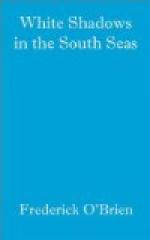“He had no wife or woman, but he took one in the way of the white man here now and then. He lived alone, save for a half-Chinese boy who cooked and cleaned for him. He never said he was sick. There was no doctor on this island, for the government was then at Nuka-hiva, and he had no time to go there. He suffered terribly, but he never complained. ‘Life is short,’ he would say, ’and there is not long to paint.’
“He would not talk politics, but after the light was gone he would sit at the organ in his studio and make one cry with his music. When at home he wore only a pareu, but he would put on trousers when he went out. He worked and drank and injected his morphine, and one morning when the boy came he found him dead, and he was smiling.
“The government hated him because he cursed it for not letting the natives keep their customs. The church hated him because he ridiculed it. Still, they buried him in the Catholic cemetery. I went with the body, and four Marquesans carried it up the trail.
“The government sold his house to Gedge, and Gedge sold it to a native, who tore it down for the materials. It was of no use to any one, for it was built for an artist.
“Vous savez; mon garcon, I am not acquainted with pictures, and have never seen any but his, but I felt that they were good. They made one feel the sun. There was in them the soul of these islands. And you know that Polonaise, with the one eye-glass, that lives in Papeite, that Krajewsky? Eh bien! he was here to buy these stone images of gods, and he said that in Paris they were paying tens of thousands of francs for those things of Gauguin’s he would have given me for the asking. Ah well! he had the head and he was a philosopher, but he lies up there in Calvary.”
“Perhaps,” said Le Moine.
“Mon ami,” said the shaggy man, “I go to church, and you and I and Gauguin are the same kind of Catholic. We don’t do what we pray for. That man was smarter than you or me, and the good God will forgive him whatever he did. He paid everybody, and Chassognal of Papeite found seven hundred francs in a book where he had carelessly laid it. If he drank, he shared it, and he paid his women.”
“He was an atheist,” persisted Le Moine.
“Atheist!” echoed Baufre. “He believed in making beautiful pictures, and he was not afraid of God or of the mission. How do you know what God likes? Mathieu Scallamera built the church here and the mission houses, and he is dead, and all his family are lepers. Did God do that? Non! Non! You and I know nothing about that. You like to drink. Your woman is tattooed, and we are both men and bad. Come and have a drink?”
We left him beside the road and walked slowly beneath the arch of trees toward the mountain whose summit was crowned by the white cross of Calvary graveyard.
“He drank too much, he took morphine, he was mortally ill, and yet he painted. Those chaps who have to have leisure and sandal-wood censors might learn from that man,” said Le Moine. “He was a pagan and he saw nature with the eyes of a pagan god, and he painted it as he saw it.”




